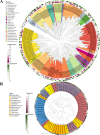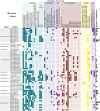Decoding microbial diversity, biogeochemical functions, and interaction potentials in red sea hydrothermal vents
- PMID: 41024198
- PMCID: PMC12482716
- DOI: 10.1186/s40793-025-00784-5
Decoding microbial diversity, biogeochemical functions, and interaction potentials in red sea hydrothermal vents
Abstract
Background: Hydrothermal vents along mid-ocean ridges host diverse microbial communities and are crucial to global elemental cycling. The Red Sea, known for its unique environmental conditions-including low nutrient levels, high year-round temperatures, bottom-water temperatures of 21 °C, and elevated salinity-hosts recently discovered active low-temperature hydrothermal vent fields at the axial Hatiba Mons volcano. These vents, characterized by large iron oxide mounds and abundant microbial mats, offer an extreme environment for studying the diversity and functions of prokaryotes involved in elemental cycling in this system. In this study, we used 16S rRNA sequencing and shotgun metagenomics to examine the microbial diversity and metabolic capabilities of precipitates and microbial mats from five vent sites.
Results: We recovered 314 non-redundant metagenome-assembled genomes (MAGs), including 250 bacterial and 64 archaeal MAGs, representing 34 bacterial and 11 archaeal phyla. Functional annotations revealed diverse nutrient and metal cycling potentials, with notable enrichment in iron redox genes. Key players include Bathyarchaeia and Chloroflexi in the precipitates (contributing to carbon, nitrogen, sulfur, and metal cycling potentials) and Pseudomonadota members in the microbial mats and upper precipitates (involved in iron and sulfur metabolism and carbon fixation through the CBB cycle). Carbon fixation in precipitate potentials primarily occurs through the Wood-Ljungdahl pathway. Sulfur and nitrogen cycling genes are distributed across various genomes, indicating collaborative cycling.
Conclusion: Our genome-resolved analysis positions the Hatiba Mons vents as an iron-rich system that provides new insights into oligotrophic hydrothermal environments, with potential relevance for understanding novel metabolic pathways, extremophilic adaptations, and their roles in element cycling and biotechnological applications.
Keywords: Biogeochemical cycling; Carbon fixation; Extremophiles; Hatiba mons; Hydrothermal vents; Iron metabolism; Metagenome-assembled genomes; Microbial diversity; Red sea; Shotgun metagenomics.
© 2025. The Author(s).
Conflict of interest statement
Declarations. Ethics approval and consent to participate: Not applicable. Consent for publication: Not applicable. Competing interests: The authors declare no competing interests.
Figures






References
-
- Sievert SM, Hügler M, Taylor CD, Wirsen CO. Sulfur Oxidation at Deep-Sea Hydrothermal Vents. In: Dahl C, Friedrich CG, editors. Microbial Sulfur Metabolism. Berlin, Heidelberg: Springer Berlin Heidelberg; 2008 [cited 2024 July 23]. pp. 238–58. Available from: http://link.springer.com/10.1007/978-3-540-72682-1_19
-
- Namirimu T, Kim YJ, Park MJ, Lim D, Lee JH, Kwon KK. Microbial community structure and functional potential of Deep-Sea sediments on low activity hydrothermal area in the central Indian ridge. Front Mar Sci. 2022;9:784807.
Grants and funding
- BAS/1/1096-01-0/King Abdullah University of Science and Technology
- BAS/1/1096-01-0/King Abdullah University of Science and Technology
- BAS/1/1096-01-0/King Abdullah University of Science and Technology
- FCC/1/1973-43-01/King Abdullah University of Science and Technology
- FCC/1/1973-43-01/King Abdullah University of Science and Technology
LinkOut - more resources
Full Text Sources
